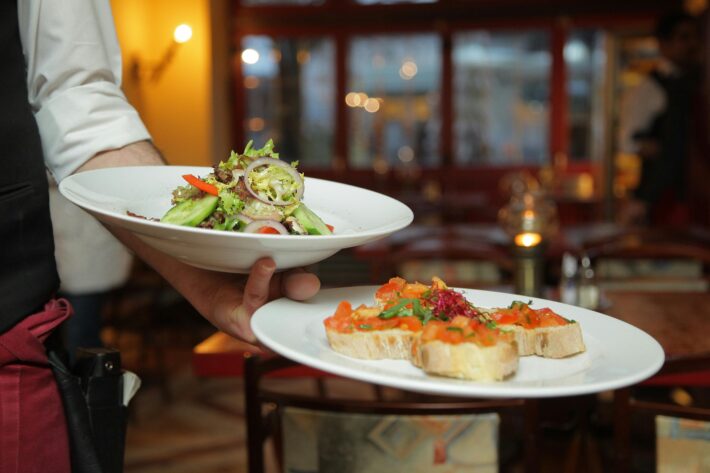How Restaurants Can Use AI for Online Ordering & Delivery

Introduction
The restaurant industry is rapidly evolving, driven by the changing preferences of consumers and the advent of new technologies. In recent years, one of the most transformative technologies has been artificial intelligence (AI). With the rise of online ordering and delivery services, restaurants are now leveraging AI in food & restaurants to enhance efficiency, improve customer experiences, and streamline operations. This approach is not only a trend but also a necessity for restaurants that want to thrive in a competitive marketplace.
Consider Domino’s Pizza, which has harnessed AI to significantly enhance its online ordering experience. By utilizing machine learning algorithms, the company has improved its customer engagement levels and optimized delivery routes, resulting in faster service and increased customer satisfaction. In an era where convenience is king, understanding how to effectively integrate AI into online ordering and delivery systems is crucial for modern restaurants.
In this blog post, we will explore how restaurants can harness the power of AI in food & restaurants to optimize their online ordering and delivery processes. We will discuss key strategies for implementation, best practices to follow, and real-world case studies that illustrate both successful and failed attempts at using AI in this context. By the end of this article, restaurant owners and managers will have a comprehensive understanding of how to leverage AI to improve their operations and meet the evolving needs of their customers.
Key Strategies for AI in Food & Restaurants
1. Personalized Customer Experiences
One of the most impactful applications of AI in food & restaurants is the ability to deliver personalized experiences to customers. Personalization is not just a marketing buzzword; it is a strategy that can significantly enhance customer loyalty and increase sales. By analyzing customer data, AI systems can identify preferences, dietary restrictions, and previous orders, allowing restaurants to tailor their offerings accordingly.
#### Why Personalization Matters
Personalized experiences lead to higher customer satisfaction and retention rates. According to a study by McKinsey, personalization can drive revenue growth of 5% to 15% for retailers. In the restaurant context, this means that by using AI to analyze customer data, restaurants can create personalized menus and recommendations that resonate with individual diners.
#### Implementation Steps
1. Data Collection: Start by collecting data through loyalty programs, online orders, and customer feedback. Make sure the data is stored securely and complies with privacy regulations.
2. Choose the Right AI Tools: Invest in AI tools that can analyze customer data effectively. Tools like machine learning algorithms can help identify patterns in customer behavior.
3. Develop Personalized Menus: Use insights from AI analysis to create personalized menu recommendations for each customer based on their past orders and preferences.
4. Test and Iterate: Implement the personalized offerings and monitor customer feedback. Use this information to continuously refine and improve the personalization process.
#### Real-World Example
A well-known example of personalization in the restaurant industry is Starbucks. The coffee giant uses its mobile app to track customer purchases and preferences. By leveraging AI, they offer personalized drink recommendations, targeted promotions, and customized rewards, thereby enhancing customer engagement and loyalty.
- Benefits of Personalization:
– Increases customer satisfaction and loyalty.
– Enhances marketing effectiveness through targeted promotions.
– Improves operational efficiency by predicting demand for certain items.
– Increases average order value through tailored upselling.
– Reduces waste by predicting inventory needs based on customer preferences.
For more on this topic, refer to this Forbes article.
2. Optimizing Delivery Logistics
Another significant area where AI in food & restaurants can make a difference is in optimizing delivery logistics. With the rise of online ordering, restaurants must be able to deliver food quickly and efficiently. AI can help streamline this process by analyzing data related to delivery routes, traffic patterns, and order volumes.
#### Why Efficient Delivery Logistics Matter
Efficient delivery logistics not only enhance customer satisfaction by ensuring timely deliveries but also reduce operational costs. According to a report by Statista, the global online food delivery market is expected to reach $154.34 billion by 2023. This growth emphasizes the importance of having a robust delivery system in place.
#### Implementation Steps
1. Route Optimization Algorithms: Invest in AI-powered route optimization tools that can analyze real-time traffic data to find the quickest delivery routes.
2. Predictive Analytics for Demand Forecasting: Use AI to analyze historical data and predict peak ordering times. This can help restaurants allocate resources accordingly.
3. Real-time Monitoring: Implement systems that allow real-time monitoring of deliveries. This includes tracking delivery personnel and providing customers with updates on their order status.
4. Feedback Loop: Create a feedback loop where delivery personnel can report issues or delays, allowing the system to learn and adapt for future deliveries.
#### Actionable Takeaways
- Use AI to reduce delivery times, which can lead to higher customer satisfaction.
- Analyze data to predict the busiest times and adjust staffing levels accordingly.
- Implement real-time tracking features in your online ordering system to keep customers informed.
A study published by the National Bureau of Economic Research found that AI-driven optimization can reduce delivery times by as much as 20%.
Best Practices for AI in Food & Restaurants
Key Actionable Tips
1. Leverage Customer Feedback: Collecting and analyzing customer feedback is crucial for improving AI implementations. Use this data to refine your algorithms and enhance customer experiences. For example, if customers consistently express dissatisfaction with delivery times, utilize this feedback to adjust your logistics strategy.
2. Integrate AI with Existing Systems: Ensure that your AI solutions integrate seamlessly with your current POS systems and ordering platforms. This will help in creating a unified experience for both staff and customers. An integrated system can also provide more accurate data for your AI algorithms to analyze.
3. Train Staff on AI Tools: Provide training for your staff to ensure they understand how to use AI tools effectively. This is important because the human element is still crucial in the restaurant industry, and well-trained staff can maximize the potential of AI technologies.
4. Focus on Data Security: As you collect more customer data for AI applications, ensure that you comply with data protection regulations. Implement robust security measures to protect sensitive information, which will also help build customer trust.
5. Measure Success Metrics: Establish clear metrics to measure the success of your AI implementations. This could include tracking customer satisfaction scores, delivery times, and sales growth. Regularly reviewing these metrics will help you identify areas for improvement.
Common Mistakes to Avoid
- Neglecting Data Privacy: One common mistake restaurants make when implementing AI is failing to prioritize data privacy. Without proper measures in place, restaurants risk breaching customer trust and legal regulations. Always ensure that customer data is collected, stored, and used in compliance with applicable laws.
- Overcomplicating AI Solutions: Another mistake is overcomplicating AI solutions. While it may be tempting to implement advanced algorithms, simpler applications often yield better results. Start with straightforward solutions that can be easily understood and managed by staff.
Real-World Case Studies
Case Study 1: Domino’s Pizza
Domino’s Pizza is a prime example of successfully implementing AI in food & restaurants. The company has integrated AI-driven chatbots into its ordering system, allowing customers to place orders via voice commands or text messages. This innovation has not only streamlined the ordering process but also enhanced customer convenience. By analyzing customer interactions, Domino’s continuously improves its chatbot capabilities, leading to higher satisfaction rates.
Case Study 2: ChowNow’s Delivery Debacle
On the other hand, ChowNow, a food ordering platform, faced challenges when it attempted to scale its delivery services. The company underestimated the complexities involved in logistics optimization and customer support. As a result, the initial implementation led to delays and customer complaints. However, by learning from these mistakes, ChowNow adjusted its approach, focusing on better integration of AI tools and customer feedback, ultimately leading to a successful turnaround.
Conclusion
The integration of AI in food & restaurants offers numerous opportunities for enhancing online ordering and delivery services. By focusing on personalization, optimizing logistics, and following best practices, restaurants can significantly improve their operations and customer satisfaction. As we have seen through real-world examples, successful implementation relies on understanding customer needs, leveraging data effectively, and continuously refining processes.
As the restaurant industry continues to evolve, embracing AI will become increasingly vital for success. For those looking to stay ahead of the curve, it is essential to explore how AI can be effectively integrated into various aspects of restaurant operations.
For more insights, check out our blog or contact us for expert guidance.


